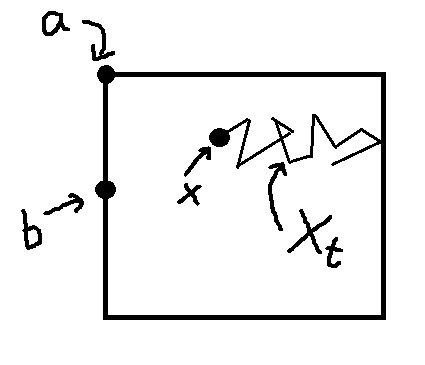I have a question about a reflecting Brownian motion and its boundary local time.
Bass and Hsu that the existence of Reflecting Brownian motion and boundary local time on a bounded Lipschitz domain in 1991. Although I don't state the definition of boundary local time here, I will briefly explain what it is. Roughly speaking, boundary local time $\{L_{t}\}$ is a additive functional on a probability space and satisfies the following the equation: \begin{align*} L_{t}=\int_{0}^{t}1_{\left\{X_{s} \in \partial D \right\}}\,dL_{s}, \end{align*} where $\{X_{t}\}$ is a Reflecting Brownian motion on $\bar{D}$ (closure of a bounded Lipschitz domain $D$). That is, $L_t$ increases only when $X_t \in \partial D$.
Question
Let $D$ be a rectangle like as the follwong picture. Even in this case, we can define reflecting Brownian motion $(X_t,P_x)$ starting from $x \in \bar{D}$ and boundary local time $\{L_{t}\}$.
I am interested in the quantity $ P_{x}(L_t>M), $ where $M$ is a positive constant.
I think $P_{a}(L_t >M) \ge P_{b}(L_t >M)$, where $a,b$ are boundary points in the following picture. But I don't know how to prove this inequality. If you know related studies, please let me know.
ADD $\{X_t\}$ is Brownian motion in $D$ with normal reflection at the boundary.

